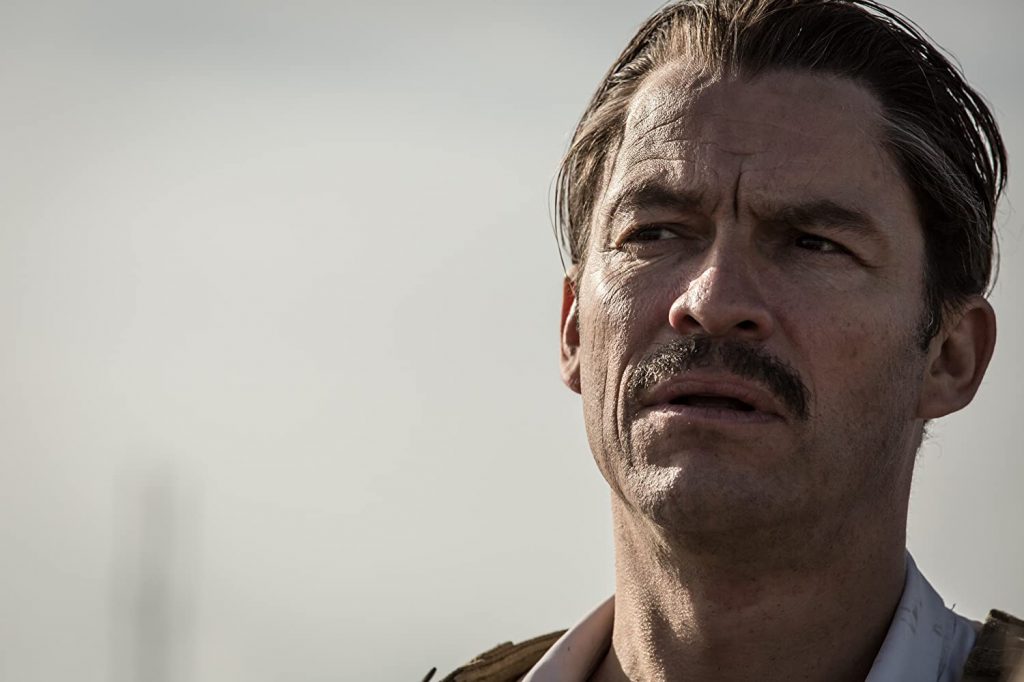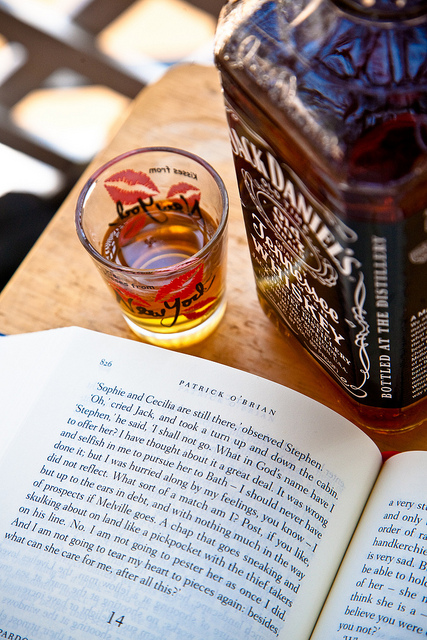How To Drink Like Your Favorite Writer: From Hemingway to Faulkner
Please note: We do not intend to condone nor glorify substance abuse. But it does make for some good stories. That being said, read on and learn how to drink like your favorite author.
Ernest Hemingway (Absinthe / Death in the Afternoon): Ernest Hemingway was known for a lot of things — but right now, we’re going to focus on his drinking habits rather than his blatant misogyny. Hemingway was a known advocate of absinthe, a green liquor made from wormwood and other herbs that was commonly referred to as “The Green Fairy” due to the presence of a chemical compound called thujone that is thought to induce hallucinations (you know, like fairies).
If you want to drink like Hemingway, know that he preferred to drink his absinthe as part of a concoction called “Death in the Afternoon” (named after his own nonfiction book of the same name). He describes the cocktail preparation as such: “Pour one jigger absinthe into a Champagne glass. Add iced Champagne until it attains the proper opalescent milkiness. Drink three to five of these slowly.”
That being said, Hemingway was not known for, uh, healthy habits involving alcohol, so uh, maybe you shouldn’t try quite the same dosage. I’d start with one, maybe two, and then go from there.

William Faulkner (Mint Julep via Joy the Baker): “There’s no such thing as bad whiskey,” Faulker once wrote. “Some whiskeys just happen to be better than others.” Which is particularly fitting coming from a master of the Southern Gothic genre, where the bourbon flows as freely as the Mississippi River, if the stories are to be believed. (Okay well I’ve never actually been to Mississippi, but he was born there, so it seemed fitting) Faulkner is still recognized as a kind of champion of hard drinking writers; by all accounts, the man literally required whiskey in order to put a word on the page. In his own words: “I usually write at night. I always keep my whiskey within reach; so many ideas that I can’t remember in the morning pop into my head.”
I assume that Faulkner was generally able to get these ideas down on the page before he passed out, so that his brilliant ideas that were otherwise lost in the morning were somehow still salvaged for the future. Although some sources actually insist that Faulkner avoided drinking while working, all can agree that upon completion of a project, he would go out on a bender that would last for several days as a means of escape and decompression.
Whatever his habits, Faulkner preferred to take his whiskey in the form of a mint julep. He even had a metal cup that he preferred to drink out of, which stands on display to this day at the William Faulkner House in Oxford, Mississippi, accompanied by his personal recipe: whiskey, 1 teaspoon of sugar, ice, and mint. Simple enough — and quite delicious!

F. Scott Fitzgerald (Gin Rickey via Food52): It’s only fitting that the man who brought us the raucous parties of The Great Gatsby know a thing or two about partying himself. He and his wife Zelda were a raging pair of drunken pranksters, a ferocious force to be reckoned with. I mean, when your buddy Ernest Hemingway tells you that your wife is a bad influence on you and makes you drink too much? That’s saying something.
The Fitzgeralds’ decadent lifestyle did not come without its consequences, but that’s a story better saved for the sequel. “First you take a drink, then the drink takes a drink, then the drink takes you,” said Fitzgerald, and for he and Zelda, that drink was the gin rickey (supposedly, he thought that gin was more difficult for others to detect on your breath): 2 shots of gin mixed with ¾ oz of lime juice, poured over ice in a highball glass and topped with club soda and a garnish of lime. While I can’t guarantee this drink’s discretion, I can guarantee a deliciously refreshing cocktail.

Dylan Thomas (18 Whiskeys In A Row): That’s what the famous Welsh poet Dylan Thomas drank on the night he died, and a proud feat for him it was. Remarkably, it was pneumonia that killed him, and perhaps he would have been ashamed of the miraculous lack of damage his drinking habits had done to his liver over the course of his lifetime. Instead, I imagine that Dylan Thomas would have actually preferred to be remembered for the glamour and glory of downing 18 straight whiskeys at the White Horse Tavern in Greenwich Village. If anything, a drinker of Dylan Thomas’s stature certainly did not go gentle into that good night.

Flann O’Brien (Irish Stout): Born Brian O’Nolan, the man most famously known as Flann O’Brien also wrote in the Irish language under the name Myles na gCopaleen or occasionally Brother Barnabas. Whether this wildly disparate association of identities came about beforehand, or was as a result of his varied body of work, no one can say for certain, as very little is known about his (their?) private life. What is known is that O’Brien was raised in an Irish-speaking family in County Tyrone and worked for many years as an Irish civil servant.
His writing ran the gamut from maddeningly metafictional parodies (At-Swim Two Birds) and wild existential comedies (my personal favorite, The Third Policeman, which was frequently referenced on the TV show LOST) to political journalism and scientific writing (he was a renowned forward thinker on thermodynamics and atomic theory) and beyond. But perhaps his most well-recognized work is a remarkably straight-forward poem simply titled “The Workman’s Friend”:
When things go wrong and will not come right,
Though you do the best you can,
When life looks black as the hour of the night —
A PINT OF PLAIN IS YOUR ONLY MAN
When money’s tight and hard to get
and your horse is also ran,
When all you have is a heap of debt,
A PINT OF PLAIN IS YOUR ONLY MAN
… and so on and so forth for three more stanzas (but you get the gist). “Plain” is another name for Irish stout beer. I’d say that Flann O’Brien makes his preference pretty clear here, wouldn’t you? Now of course, no one can say for certain whether Myles na gCopleen, or Brian O’Nolan, or Brother Barnabas, or any of his other aliases shared the same tastes, but for Flann, at least, a dark stout such as Beamish, Murphys, or Guinness was the cure for any ailment. Was he right? Well, there’s only one way to test that theory.

Brendan Behan (Whiskey): As I type this, I am sitting — yes, with my laptop — at the Brendan Behan Pub in Boston, MA. Even if this weren’t my single favorite pub on the entire planet (which has nothing to do at all with its proximity to my home; no, really), I’d probably still tend to frequent it as much as I do because of my affections for Brendan Behan as a writer. A self-described “drinker with a writing problem,” Behan essentially perfected the archetype of the drunken Irish storyteller, a type of celebrity that he embraced to a fault. “I only drink on two occasions,” he famously wrote. “When I’m thirsty, and when I’m not.” He met his unfortunate end while sitting on his favorite barstool at the Harbour Lights Bar in Dublin, but has since been immortalized in song by The Pogues, The Mighty Mighty Bosstones, The Mountain Goats, Thin Lizzy, and others.
If you’re looking to drink after the reputation of such a man, the answer is simple: whiskey. Whiskey, wild yarns, and jovial belligerence are the only way to follow in his stumbled footsteps. The word “whiskey” is derived, of course, from the old Irish “uisce beatha,” literally meaning “water of life,” and there was no one for whom this translation held more true than Brendan Behan (that is, until it didn’t).

Hunter S. Thompson (Wild Turkey): The original “Gonzo Journalist,” Hunter S. Thompson spun his immersive journalism into wild subjective yarns, often filled with fictional autobiographical surrogate characters and almost always fueled by some dazzling cocktail of drugs, alcohol, and general madness.”I hate to advocate drugs, alcohol, violence, or insanity to anyone, but they’ve always worked for me,” persists as one of his most popular lines, and Thompson did not skimp on living out that saying to its fullest extent.
Thompson’s lifestyle and philosophies inspired the founding of Flying Dog Brewery by his friends and collaborators, but Thompson is most remembered for his love of Wild Turkey Bourbon, a particularly strong brand of Kentucky bourbon that finds its way into many of the adventures in his book Fear and Loathing in Las Vegas. He was even known to force other journalists who were interviewing him to consume Wild Turkey during the interview, or else he wouldn’t participate. Of course, if you really wanted to drink like Hunter S. Thompson, you might want to try your Wild Turkey with a dash of prescription pills and/or hallucinogens, but let’s start small for now.

Raymond Chandler (Whiskey or Gimlet): Whether Chandler preferred whiskey or a gimlet (combining 2oz gin and Rose’s Lime Juice) is up for debate, as many people tend to confuse him with the hardboiled, first-person protagonists of his stories. He definitely drank both, and drank often, and in large quantities. Chandler own lifestyle probably inspired the noir archetype of the hard-drinkin’ detective as much as his books did. The most famous story goes that when he found himself unable to complete the screenplay for The Blue Dahlia, he went on a week-long bender, fully supported by the movie studio. He consumed nothing but bourbon for a week as he pounded out the ending of the script, and the film producers hired a doctor to inject him with vitamins twice a day, as well as a number of secretaries to be at the ready to assist with dictation, typing, and other emergencies, should the need arise.
It worked. Eight days later, the script was finished. A month after that, Chandler finally recovered from his hangover. “Alcohol is like love,” he once wrote. “The first kiss is magic, the second is intimate, the third is routine. After that you take the girl’s clothes off.”
—
Thom Dunn is a writer, musician and comic book fan. Follow him on Twitter (@thomdunn) and visit his blog at thomdunn.net.
—




